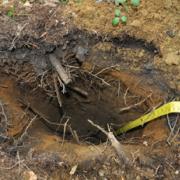AirMOSS
P-band Radar
UAVSAR pod under the Gulfstream-III (G-III) aircraft (left) and the modular
design of the pod electronics bay, which enables us to adapt the radar to operate in different frequencies
with ease.
The NASA/JPL UAVSAR is a pod-based repeat-pass polarimetric SAR that currently operates in L-band (1.2 Ghz). The AirMOSS radar replaces the L-band front-end electronics and antenna with components that operate at P-band. The major components of the P-band front-end electronics are based on AIRSAR and GeoSAR heritage, and the P-band antenna utilizes the GeoSAR P-band antenna design.
AirMOSS utilizes a passive dual-polarized array antenna based on the GeoSAR P-band antenna design to take advantage of the good polarization isolation over the bandwidth of 280 to 440 MHz.
The radar utilizes the L-band RF electronics and an arbitrary waveform generator (AWG) from UAVSAR. The L-band transmit pulse is down-converted to P-band by mixing it with a tone from a direct digital synthesizer (DDS). The P-band transmit pulse is then amplified and sent to either the horizontal (H) or the vertical (V) polarization channel of the passive antenna. The transmit bandwidth is determined by the AWG and the selection of one of four filters (6, 20, 40, or 80 MHz) in a filter bank.
The radar has two identical receive chains. Both the H and the V radar returns are up-converted to L-band by mixing them with the same tone from the DDS as was used on transmit. The radar return is filtered using an identical filter bank as on transmit and then enters the UAVSAR receive electronics.

Example of AirMOSS pulse-to-pulse frequency selectability. This is not a nominal
AirMOSS operating mode.
The P-band radar flies on the Gulfstream-III (G-III) jet operated by JSC
In situ Ground Sensors
Each of the AirMOSS study areas is collocated with a FLUXNET meteorological tower, which also includes instrumentation to measure root-zone soil moisture (RZSM) within the tower footprint (~1 km).
For most of the AirMOSS study areas, additional ground sensor profiles will be installed to measure spatial patterns of RZSM over the modeling grid cell, at several depths ranging from 2 cm down to approximately 100 cm. Sensors at each depth will include thermisters to measure soil temperature, heated ceramic needles to measure soil matric potential, and frequency domain reflectometers to measure soil moisture content. Additionally, each sensor profile will also include a thermal IR sensor for measuring surface soil temperature and a tipping bucket rain gage to measure precipitation.
The ground sensors measurements will be archived as the L2-IGSM and L2-Precip products.
For more info, see Prof. Richard Cuenca's website.
ALAR
Airborne Laboratory for Atmospheric Research (ALAR)
The Airborne Laboratory for Atmospheric Research (ALAR) platform is a light twin engine aircraft, a Beechcraft Duchess, instrumented with a GPS/INS attitude system, and a turbulence probe (BAT probe) mounted on the nose. This system enables 50Hz 3D winds, enabling its use for airborne flux measurements. The wind system has been wind-tunnel calibrated (Garman et al., 2006). The vertical wind uncertainty is +/-6cm/s. The aicraft has an all-Teflon fast sampling system to enable eddy covariance flux measurements, and fast response CO2 instrumentation. We often fly with a spectral radiometer for surface reflectance measurements. The aircraft also has a cloud water collector.
For AirMOSS, the ALAR platform is being augmented with a Picarro Wavelength-Scanned Cavity Ring Down Spectrometer (WS-CRDS), a greenhouse gas analyzer that will measure spatial variations in atmospheric CO2, CH4 and H2O over selected study areas. This data will be used to validate the model simulations and the upscaling process of NEE from the flux-tower to the modeling grid cell.
Data from ALAR will be archived as the L2-CFlux product.
For more information about ALAR, see Prof. Paul Shepson's website.







